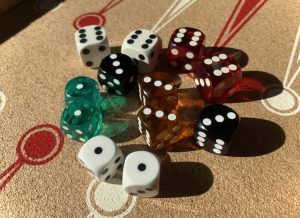While we hope these comments, pictures and descriptions will be helpful in guiding your interest, NEBC is not explicitly endorsing any of these products, and has not received any benefit from listing them here. CLICK ON ANY PRODUCT IMAGE to visit the vendor’s site.
Checkers
Why buy checkers separately? If you’re buying a custom backgammon set, it’s best to start with the checkers, and then build the board around them. Or perhaps you already found a board you like, but don’t like the checkers that came with it. When buying checkers separately, make sure to take into account the thickness of the checkers as well as the diameter, so they’ll store properly in your checker tray. Click on the checker image to visit the online distributor.
Crisloid
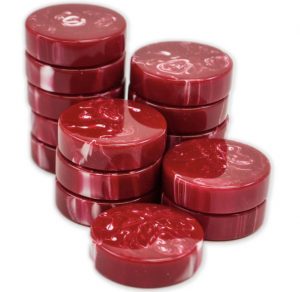 Crisloid has been in the business a long, long time, producing checkers in a variety of materials available over the years, including bakelite. Now that bakelite can no longer be produced due to environmental factors, Crisloid checkers are made of a “high quality resin” in a variety of colors with a traditional white swirled effect that helps the checkers stand out against similar-colored board points.
Crisloid has been in the business a long, long time, producing checkers in a variety of materials available over the years, including bakelite. Now that bakelite can no longer be produced due to environmental factors, Crisloid checkers are made of a “high quality resin” in a variety of colors with a traditional white swirled effect that helps the checkers stand out against similar-colored board points.
Crisloid’s standard 1.75″ and 1.5″ checkers are .5″ thick, giving them a nice “chunky” feel and which incidentally make it a bit harder to roll dice up on top of them requiring a re-roll. The extra thickness is well-suited to Crisloid’s standard “attache” portable sets, which have a deep 1.75″ frame (1″ playing depth is more typical these days), so take this factor into consideration before buying Crisloid checkers for a non-Crisloid set.
Crisloid does offer a wider variety of checker options with some of their “signature” or custom backgammon offerings, so if you see something you like, try contacting them directly to see whether they’re available on their own.
Generic Plastic / Melamine / Acrylic
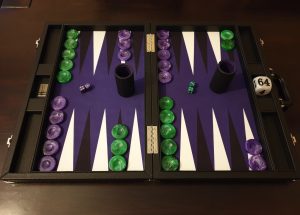 GammonVillage offers a very wide array of plastic, wooden, and metal checkers in a variety of colors and sizes to suit your fancy. Note that some styles are available only in “rolls of 15 checkers,” while there is another category for “sets of 30 checkers” to explore.
GammonVillage offers a very wide array of plastic, wooden, and metal checkers in a variety of colors and sizes to suit your fancy. Note that some styles are available only in “rolls of 15 checkers,” while there is another category for “sets of 30 checkers” to explore.
Apart from material, finish, and size, you will need to decide whether you want checkers with “finger dish” depressions in them (elsewhere called “finger dip” or simply “dipped” checkers). Some people find that these depressions make checkers easier to grasp as you slide them across the playing surface, but most playing surfaces are smooth enough for this to be a minor factor. The biggest difference is probably aesthetic, as the bowls create curves that catch the light, adding some extra visual texture to your set. A potential downside that some find annoying is that dipped checkers tend to catch a die more readily, requiring more frequent re-rolls.
Pictured is a Wycliffe Brothers set with original checkers replaced with finger-dish “melamine” plastic checkers from Gammon Village for a fancier look. (Image courtesy of Sascha Jung.)
Zaza & Sacci
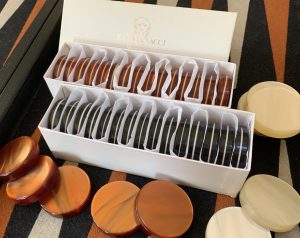 Zaza & Sacci checkers appear only to be available from GammonVillage, and they are well worth a look. The “high-gloss pearled acrylic” material option yields a subtle and lustrous beneath-the-surface texture that evokes mother of pearl, and is a valuable in a nice range of colors . A mottled “grizzly acrylic” style is also available, as are flat-color options.
Zaza & Sacci checkers appear only to be available from GammonVillage, and they are well worth a look. The “high-gloss pearled acrylic” material option yields a subtle and lustrous beneath-the-surface texture that evokes mother of pearl, and is a valuable in a nice range of colors . A mottled “grizzly acrylic” style is also available, as are flat-color options.
Also intriguing is a more expensive “weighted” option which, while the same thickness as the standard checker, have a metal lozenge embedded in the center, providing extra 12 grams of heft and also a distinctive white ring along the edges. Of course, this will add to your set’s carrying weight, and many players will find the checkers more difficult to play with.
Pictured are amber and ivory Zaza & Sacci checkers purchased for use with a custom Bob Zavoral set, and two sets of the weighted checkers as delivered in their original box.
Artgammon
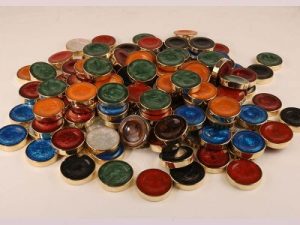 The Turkish company Artgammon sells an assortment of polyester and metal-banded checkers along with or independent of their backgammon sets. The appeal of gleaming metallic bands (in brass, brushed or nickel options) framing gemlike sparkling colors is evident, but some players may find the weight of them somewhat of a burden in actual game play. Explore the Artgammon site for an interesting variety of colors and styles including some handsome finger-dipped styles.
The Turkish company Artgammon sells an assortment of polyester and metal-banded checkers along with or independent of their backgammon sets. The appeal of gleaming metallic bands (in brass, brushed or nickel options) framing gemlike sparkling colors is evident, but some players may find the weight of them somewhat of a burden in actual game play. Explore the Artgammon site for an interesting variety of colors and styles including some handsome finger-dipped styles.
American equipment purveyors Gammon Guys sell Artgammon products for the American market, but appear to haver a smaller assortment of color and style options available on their website.
NEBC organizer David Kornwitz owns an Artgammon board with the brass-bound checkers, so ask him for a test-drive!
Vintage Bakelite
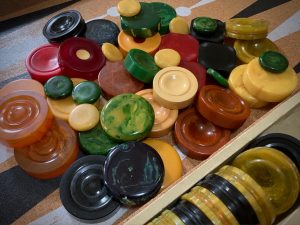
As a popular 20th-century decorative material, bakelite was a popular checker materials from the 1930’s backgammon heyday through the 1960’s, when production of the colorful plastics was phased out due to the toxic formaldehyde and asbestos materials used in its production. Since Bakelite is no longer manufactured, these checkers are “collectible” and therefore fairly pricey, particularly for sets in unusual colors or with carved surfaces or edges. For a more information on bakelite pieces, and a large gallery of images, please see this additional page devoted to the topic.
Dice & Doubling Cubes
Since the invention of doubling around the year 1930, there have been a lot of variations on the standard 6-sided cube. The only real requirement is that the numbers be legible.
Precision Dice
Even a modest-quality backgammon board will get a boost in dignity if you invest in a couple pairs of precision dice. (See the entry on dice in the ‘Backgammon Sets’ area of this website.) Precision dice for backgammon are typically available in three sizes (1/2″, 9/16″, 5/8″ — which is easier to think of in common denominators: 8/16″, 9/16″, 10/16″) and a wide variety of colors.
The medium-size dice are most popular. Larger ones are somewhat easier to read, but may not seem to get sufficient tumble on the playing surface, while also getting jammed in some baffle boxes or smaller dice cups. Smaller dice get plenty of action in shaking and rolling out, but are a little harder to read. No one hates 9/16″ dice.
Chose colors to suit your set. Hard to go wrong with simple black & white, but it’s often nice to have a third set of an accent color matching one of your checker or point colors, allowing your opponent a choice. Many people don’t like translucent dice, particularly in lighter colors, as you can see through to pips on the far side of the die and misread your roll.
Carol Joy Cole offers dice at a super reasonable price of $14 a pair from her Backgammon ala Carte store — and you can often buy them from her directly at ABT events.
30mm Acrylic Cubes
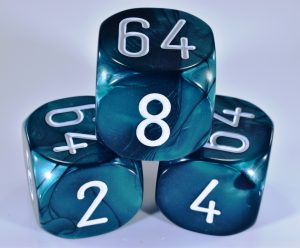 The most common doubling cubes you’ll tend to see in various backgammon sets without their own branded styles is the trusty 30mm, (1.18 inch) acrylic cube, available in a variety of colors. A practical tip: it’s natural when you’re buying multiple cubes for chouette play, to choose a varied selection of colors. But in practice, it’s pretty rare that players meaningfully identify cubes by color (“I’m the green cube.”) as a way of keeping them straight. So, if you like the color scheme of your favorite backgammon set, consider buying four chouette cubes in the single color that goes best with your set. You’ll find it’s more handsome, and avoid that one cube that really clashes with your checkers.
The most common doubling cubes you’ll tend to see in various backgammon sets without their own branded styles is the trusty 30mm, (1.18 inch) acrylic cube, available in a variety of colors. A practical tip: it’s natural when you’re buying multiple cubes for chouette play, to choose a varied selection of colors. But in practice, it’s pretty rare that players meaningfully identify cubes by color (“I’m the green cube.”) as a way of keeping them straight. So, if you like the color scheme of your favorite backgammon set, consider buying four chouette cubes in the single color that goes best with your set. You’ll find it’s more handsome, and avoid that one cube that really clashes with your checkers.
You’ll find these cubes available from various outlets, at prices up to $20.00 each. Currently the best deal we’ve seen is on Gammon Stuff, where they go for just $6.00 apiece! Gammonstuff also offers similar cubes in larger or smaller sizes, with somewhat different numeral styles, so check out the full range of options before buying!
FTH Doubling Cubes
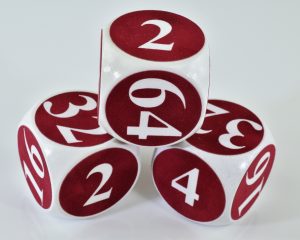 German-made FTH backgammon boards come with a large 40mm (nearly 1.5″) doubling cube. The lightweight, easy-to-read cube features fabric faces that complement the merino wool board surface, framed by softly rounded white plastic corners and edges. The cubes are also available separately in four colors (black, blue, green, red). Unfortunately, these cubes start to show their age quite quickly, as the soft and porous surfaces tend to pick up dirt. The current price is a reasonable $15.00.
German-made FTH backgammon boards come with a large 40mm (nearly 1.5″) doubling cube. The lightweight, easy-to-read cube features fabric faces that complement the merino wool board surface, framed by softly rounded white plastic corners and edges. The cubes are also available separately in four colors (black, blue, green, red). Unfortunately, these cubes start to show their age quite quickly, as the soft and porous surfaces tend to pick up dirt. The current price is a reasonable $15.00.
Gammon Stuff is the distributor of FTH equipment for the US market.
The Deliberate Doubler by Sonné
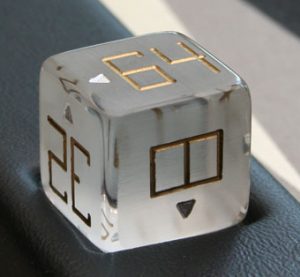 It’s one of the peculiarities of backgammon that the arrangement of numbers on doubling cubes have never really been regularized, so we’re all used to hunting around the six sides to find the number we need, so Lawrence Sonné devised this distinctive frosted acrylic cube with little arrows pointing toward the next number in the doubling sequence.
It’s one of the peculiarities of backgammon that the arrangement of numbers on doubling cubes have never really been regularized, so we’re all used to hunting around the six sides to find the number we need, so Lawrence Sonné devised this distinctive frosted acrylic cube with little arrows pointing toward the next number in the doubling sequence.
Sonné is the craftsman behind the attractive USBGF sponsor cubes as well as the new NEBC Club Champion trophy cubes. Here’s a chance to own one of his creations for $20.
Octagon Barrels by Artgammon
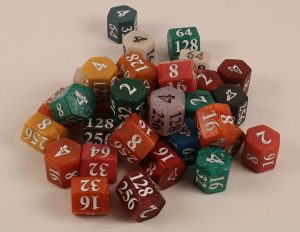 A fun variation on the traditional doubling ‘cube,’ the octagon barrel is actually a hexagonal prism, with 8 faces, providing you doubling options from 2 all the way to 256. These barrels have an appealingly compact shape, fitting snugly in a corner of your board, and come in a lively array of color options to mix or match as you please. Artgammon also offers the more traditional doubling cube in bold colors As can be seen in this image and others on their website, the precision of numeral engraving/coloring is a bit inconsistent.
A fun variation on the traditional doubling ‘cube,’ the octagon barrel is actually a hexagonal prism, with 8 faces, providing you doubling options from 2 all the way to 256. These barrels have an appealingly compact shape, fitting snugly in a corner of your board, and come in a lively array of color options to mix or match as you please. Artgammon also offers the more traditional doubling cube in bold colors As can be seen in this image and others on their website, the precision of numeral engraving/coloring is a bit inconsistent.
Gammon Guys are the United States distributors of Artgammon equipment, so you can often check out these colorful offerings at ABT tournaments attended by Ross Gordon and his team.
Katgammon Doubling Cubes
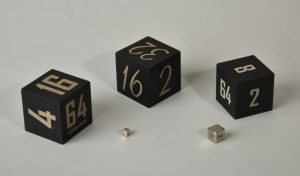 Katgammon is a new (2018) company producing offbeat backgammon equipment with a boldly modern look. Metal cubes with a steely industrial look. Playful typefaces. Cubes with commentary along with the numbers (16 – Are You Crazy?). Puzzle Cubes that rotate like a 2-tier Rubik’s Cube. Cubes that pop open to hold dice inside. Elegant black boxes with bronze-colored numerals. Fun!
Katgammon is a new (2018) company producing offbeat backgammon equipment with a boldly modern look. Metal cubes with a steely industrial look. Playful typefaces. Cubes with commentary along with the numbers (16 – Are You Crazy?). Puzzle Cubes that rotate like a 2-tier Rubik’s Cube. Cubes that pop open to hold dice inside. Elegant black boxes with bronze-colored numerals. Fun!
Dice Cups & Baffle Boxes
Dice cups and baffle boxes serve the common purpose of ensuring a truly random roll of the dice. The latter invention is generally regarded as most effective in foiling “dice mechanics” who may be able to manipulate dice in ways that even “lipped” cups cannot prevent (since adept mechanics may not even be putting both dice in the cup). But such cheating is very rare, and many players regard the ritual shaking and rolling of dice as an integral part of the backgammon experience. (Dropping dice into a baffle box doesn’t yield quite the same sense that you rolled that magical number.) On the other hand, dice emerging from a baffle box rarely result in “cocked dice” requiring a re-roll — and almost never wind up somewhere on the floor. A final factor: sound. While plastic / acrylic dice scramblers are suitable for bustling tournament rooms or taverns, they’ll earn glares in quieter public settings like a local coffee shop or restaurant. Most dice cups just sound better.
Crisloid Dice Cups
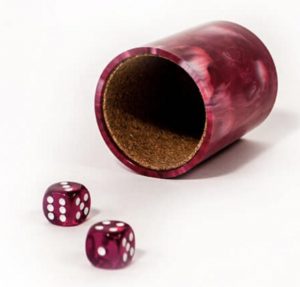 Crisloid’s round plastic dice cups in a variety of attractive swirled and flat colors, are designed to fit in the cup compartments of their portable tournament-sized sets. While serviceable, these cups are not “lipped” so the dice may slide out of the cup without tumbling, and therefore in competitive play you should make sure an opponent is shaking the dice vigorously before rolling them out. The cork interior lining will wear out over time, and at that point the cups should be retired, as the noise of dice on the plastic bottom is ear-splitting. But at just $15 a pair, you can afford to! Crisloid also makes a flattened “Travel” dice cup for smaller sets without cup compartments for just $9 a pair, but without any interior lining, they are may be noisier than you’d like.
Crisloid’s round plastic dice cups in a variety of attractive swirled and flat colors, are designed to fit in the cup compartments of their portable tournament-sized sets. While serviceable, these cups are not “lipped” so the dice may slide out of the cup without tumbling, and therefore in competitive play you should make sure an opponent is shaking the dice vigorously before rolling them out. The cork interior lining will wear out over time, and at that point the cups should be retired, as the noise of dice on the plastic bottom is ear-splitting. But at just $15 a pair, you can afford to! Crisloid also makes a flattened “Travel” dice cup for smaller sets without cup compartments for just $9 a pair, but without any interior lining, they are may be noisier than you’d like.
Crisloid also offers lipped leather dice cups that will fit in their attaché sets ($25) and larger “bar style” leather cups ($30) for use with their tabletop sets. Many players find this style of cups a bit heavy in the hand, particularly for prolonged sessions.
Wooden Dice Cups by Vinton Knarr
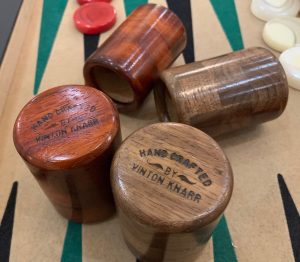 Backgammon enthusiast and master craftsman Vinton Knarr produces some of the most elegant and luxurious dice cups in the game. Often composed of dozens of individually honed pieces joined in a seamless and highly finished whole, they are a pleasure to use, both for hand-feel and for the gently musical sound your dice will make in their cork-lined interiors. The cups illustrated here measure 2″ in diameter and 3″ in height, but are offered in other sizes as well. No two pairs are exactly alike, so check with Carol Joy Cole to see what styles are currently available. Current price for these beauties is $70.00 a pair, and well worth it.
Backgammon enthusiast and master craftsman Vinton Knarr produces some of the most elegant and luxurious dice cups in the game. Often composed of dozens of individually honed pieces joined in a seamless and highly finished whole, they are a pleasure to use, both for hand-feel and for the gently musical sound your dice will make in their cork-lined interiors. The cups illustrated here measure 2″ in diameter and 3″ in height, but are offered in other sizes as well. No two pairs are exactly alike, so check with Carol Joy Cole to see what styles are currently available. Current price for these beauties is $70.00 a pair, and well worth it.
Backgammon Elegance Dice Cups by Lawrence Sonné
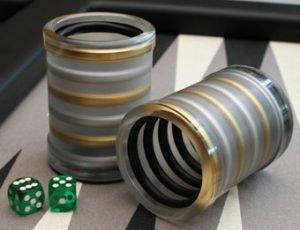 Lawrence Sonné’s dice cups aren’t just lipped — they’re ribbed all the way down the interior! The result is a cup that thoroughly scrambles the dice before they even leave the cup. Sonné has also taken careful notice of how his cups sound, so the rubbery bottom cushion and interior rings impart a pleasantly muted rattle that’s easy on the ears. The festive silver and gold coloring adds a touch of glamor, and will pair well with most backgammon boards (but may not fit in your cup compartments, so check first if that’s important to you). At $90 per pair they’re at the expensive end of the spectrum, but a reasonable price considering the high quality of their construction.
Lawrence Sonné’s dice cups aren’t just lipped — they’re ribbed all the way down the interior! The result is a cup that thoroughly scrambles the dice before they even leave the cup. Sonné has also taken careful notice of how his cups sound, so the rubbery bottom cushion and interior rings impart a pleasantly muted rattle that’s easy on the ears. The festive silver and gold coloring adds a touch of glamor, and will pair well with most backgammon boards (but may not fit in your cup compartments, so check first if that’s important to you). At $90 per pair they’re at the expensive end of the spectrum, but a reasonable price considering the high quality of their construction.
Local player Albert Steg has a pair of these cups if you’d like to test drive them.
Leather & Felt Dice Cups - Gammon Village
![]() GammonVillage offers a good variety of lipped dice cups in various shapes, sizes and materials. Their “Professional Leather Backgammon Dice Cups” ($70 a pair) are of a type popular in tournament backgammon, as they fit comfortably in the hand and provide a pleasantly soft dice-rattling sound. The dark leather and felt interiors pair well with most tournament-style backgammon boards. (Gammon Village prohibits copying of images on their site — if anyone has a nice picture of these cups, do send it along!)
GammonVillage offers a good variety of lipped dice cups in various shapes, sizes and materials. Their “Professional Leather Backgammon Dice Cups” ($70 a pair) are of a type popular in tournament backgammon, as they fit comfortably in the hand and provide a pleasantly soft dice-rattling sound. The dark leather and felt interiors pair well with most tournament-style backgammon boards. (Gammon Village prohibits copying of images on their site — if anyone has a nice picture of these cups, do send it along!)
Katgammon Dice Cups
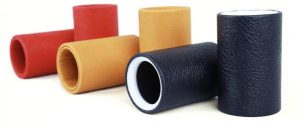 Katgammon recently added this colorful line of dice cups to its menu of backgammon accessories. The artificial-leather cups measure 9 cm. tall by 5 cm. in diameter and cost a very modest 15€ per pair.
Katgammon recently added this colorful line of dice cups to its menu of backgammon accessories. The artificial-leather cups measure 9 cm. tall by 5 cm. in diameter and cost a very modest 15€ per pair.
Katgammon Baffle Boxes
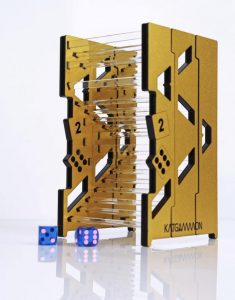 Katgammon ‘s best baffle box ticks all the boxes: attractive, lightweight, compact . . . and quiet. The flat, pliable baffles impart a rubbery bounce as the dice tumble down to the table, making this a device you can use in public without annoying anyone. The die-cut shapes in the sides are stylishly decorative but also provide visibility so the dice are never hidden from view. The golden version pictured here is one of several variations of color and style — including an option to have the back edged customized with your name — all available from Katgammon (click image). Ace Point also offers an ‘AP’ branded version, available in the US at their online shop.
Katgammon ‘s best baffle box ticks all the boxes: attractive, lightweight, compact . . . and quiet. The flat, pliable baffles impart a rubbery bounce as the dice tumble down to the table, making this a device you can use in public without annoying anyone. The die-cut shapes in the sides are stylishly decorative but also provide visibility so the dice are never hidden from view. The golden version pictured here is one of several variations of color and style — including an option to have the back edged customized with your name — all available from Katgammon (click image). Ace Point also offers an ‘AP’ branded version, available in the US at their online shop.
P-40 Scrambler
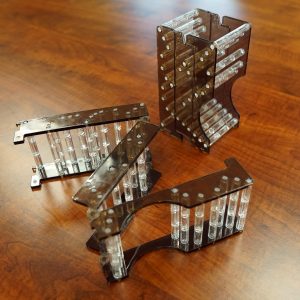 The inventive design of the P-40 Dice Scrambler ($60) reflects the ingenuity this company brought to the manufacture of their boards. The Scrambler is composed of three hinged parts which, laid flat, fit neatly into a P-40 board for easy storage, but folded up vertically, transform into an imposing tower that perches on the side of your board. The notches on the bottom of the scrambler are designed to engage with the rails of the P-40 board, so if you’ll be using it with another kind of set, you may have to experiment in order to get it to sit well — but the popularity of this device suggests that it can be made to work with a variety of boards.
The inventive design of the P-40 Dice Scrambler ($60) reflects the ingenuity this company brought to the manufacture of their boards. The Scrambler is composed of three hinged parts which, laid flat, fit neatly into a P-40 board for easy storage, but folded up vertically, transform into an imposing tower that perches on the side of your board. The notches on the bottom of the scrambler are designed to engage with the rails of the P-40 board, so if you’ll be using it with another kind of set, you may have to experiment in order to get it to sit well — but the popularity of this device suggests that it can be made to work with a variety of boards.
Pictured are two P-40 Scramblers, one unfolded and the other ready for use.
BLC Baffle Box
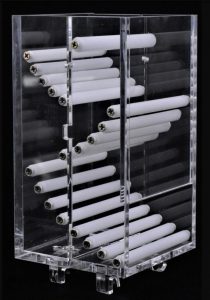 The BLC Scrambler ($65) is a product or the Backgammon Learning Center, designed with the guidance of Phil Simborg. The device is made up of two halves that cling together by the attraction of four tiny magnets set into the frame. A clever base design allows you to adjust two rails that sit parallel to the board surface so that they will fit into just about any checker tray or side compartment, keeping the Scrambler firmly upright. The crystal-clear acrylic provides perfect visibility of the dice as they tumble off the baffles with a lively rattle that may draw glares from non-playing patrons at your local Starbucks. One small technical gripe is the placement of a baffle too near the top center of the device, causing a die to bounce out a little more often than you’d like — with a little practice you’ll get used to dropping the dice down the back half, behind it.
The BLC Scrambler ($65) is a product or the Backgammon Learning Center, designed with the guidance of Phil Simborg. The device is made up of two halves that cling together by the attraction of four tiny magnets set into the frame. A clever base design allows you to adjust two rails that sit parallel to the board surface so that they will fit into just about any checker tray or side compartment, keeping the Scrambler firmly upright. The crystal-clear acrylic provides perfect visibility of the dice as they tumble off the baffles with a lively rattle that may draw glares from non-playing patrons at your local Starbucks. One small technical gripe is the placement of a baffle too near the top center of the device, causing a die to bounce out a little more often than you’d like — with a little practice you’ll get used to dropping the dice down the back half, behind it.
Clocks
While NEBC doesn’t require use of clocks except in exceptional instances of slow play, playing “on time” is worth getting used to if you intend to play at larger events on the ABT tour or elsewhere. The standard time controls are 2 minutes times match length in your “bank” and a 12-second countdown delay for each turn. So in a 9-point match you would have 18 minutes of “thinking time” to use as you like over the course of the match in addition to the 12 seconds you get each turn to roll the dice, make your move and tap the clock. For Speed Gammon events, the controls are tighter!
LEAP Chess & Backgammon Clock
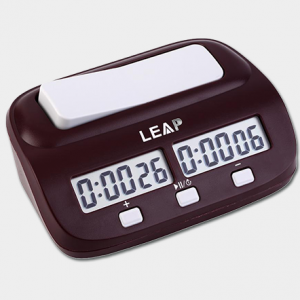 At a mere $13-$20 from various vendors, the LEAP game clock is the favorite of tournament directors who provide clocks for clock-required events. This clock has a very basic set of settings to play with, and so is very easy to set up and adjust for various match lengths, as you can see in this demo video by a young chess player. The solid and compact design makes it convenient for travel and unobtrusive at or on the side of your backgammon board, and the rocker slaps from side to side with a crisp and unambiguous action that some players prefer to the touch-sensitive style of the more expensive ZMF-II.
At a mere $13-$20 from various vendors, the LEAP game clock is the favorite of tournament directors who provide clocks for clock-required events. This clock has a very basic set of settings to play with, and so is very easy to set up and adjust for various match lengths, as you can see in this demo video by a young chess player. The solid and compact design makes it convenient for travel and unobtrusive at or on the side of your backgammon board, and the rocker slaps from side to side with a crisp and unambiguous action that some players prefer to the touch-sensitive style of the more expensive ZMF-II.
Excalibur Game Time II Gaming Clock
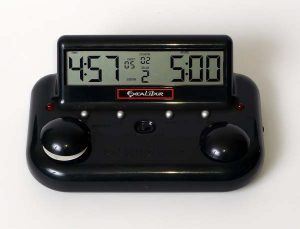 A step up from the Leap in terms of features and complexity is the Excalibur Game Time II, a favorite of the Texas State Backgammon Championships. For a thorough run-down of features and operations, check out this demo video courtesy of a chess site that seems no longer to sell the clock itself. The mechanical plungers are in the style of traditional check clocks, but once these clocks experience some wear, the plungers can get a bit “soft” and unreliable in indicating whose clock is running, so user beware.
A step up from the Leap in terms of features and complexity is the Excalibur Game Time II, a favorite of the Texas State Backgammon Championships. For a thorough run-down of features and operations, check out this demo video courtesy of a chess site that seems no longer to sell the clock itself. The mechanical plungers are in the style of traditional check clocks, but once these clocks experience some wear, the plungers can get a bit “soft” and unreliable in indicating whose clock is running, so user beware.
GammonVillage offers the Excalibur in black for $50, but elsewhere you can find it in red if that’s your preference.
ZMF-II Chess Clock
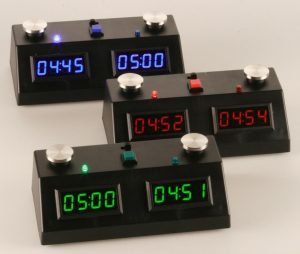 The ZMF-II ($40 – $55) has emerged as a favorite clock in the backgammon community. The crisp LED time display is vivid and easy to read, both in person and on streaming video screens. The rich array of settings give you plenty of options (audible beep, flashing countdown, etc.), and you can store multiple time-controls so you can shuttle between your standard and speed-gammon settings rather than having to keep changing them back and forth in the somewhat complicated menu of options. The folks at Wholesale Chess have provided a helpful demo video.
The ZMF-II ($40 – $55) has emerged as a favorite clock in the backgammon community. The crisp LED time display is vivid and easy to read, both in person and on streaming video screens. The rich array of settings give you plenty of options (audible beep, flashing countdown, etc.), and you can store multiple time-controls so you can shuttle between your standard and speed-gammon settings rather than having to keep changing them back and forth in the somewhat complicated menu of options. The folks at Wholesale Chess have provided a helpful demo video.
Rather than employing a mechanical plunger or rocker, the touch-sense buttons are activated by the slightest touch of a finger for highly reliable activation. (But note that tapping the plunger with a dice cup won’t work!) Four ‘C’ batteries purportedly allow for 1600 hours of play before needing replacement.
ZMF-II clocks are available in several color options (pink! clear!), and there is also a larger ZMF-Pro model with a large LCD display available on their site.
One consideration you should take into account is how well any clock will fit onto the checker tray of your backgammon board, or at its side. It is very annoying to use a clock that wobbles or shifts every time you hit it!

